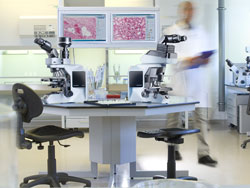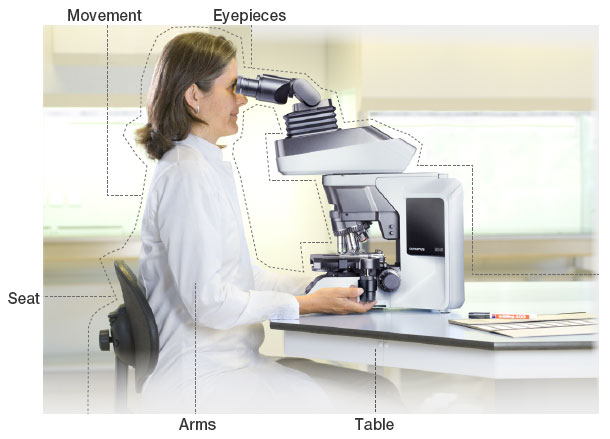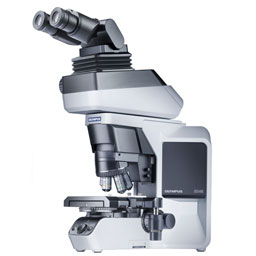Routine Microscopy: Improving Productivity Through Better Ergonomics
“For histopathologists, it’s very important to have a fully ergonomic microscope, because we do a lot of microscopy ... four to six hours a day is quite common.” Delaram Kermani, a consultant cellular pathologist at North Middlesex University Hospital certainly knows about this, having unfortunately experienced work-related pains and injuries first hand.
In this article, James Geary, physiotherapist at the Royal Lancaster Infirmary, Lancaster, UK, describes the issues encountered by professionals carrying out daily microscopy tasks. A five-point checklist will detail a step-by-step guide to setting up a microscope with ergonomics in mind and Delaram’s story will demonstrate how changes in both equipment and customisation can have immediate real-world benefits, reducing pain and improving productivity.
| At a Glance
|
Ideal Working Conditions in Microscopy
In the modern world, ergonomics is everywhere; a dictionary defines ergonomics as “the scientific study of people and their working conditions, especially done in order to improve effectiveness.” Working in an ergonomically designed environment helps to prevent injuries and contributes to general staff wellbeing and productivity. When it comes to microscopy, ergonomics is particularly important as the nature of the work puts unusually specific constraints on the operator’s posture. As physiotherapist James Geary points out, “Operators tend to have their necks in a slightly forward position to reach the eyepieces. This often leads to an overuse of the muscles in the back and the neck as well as compressing the front of the neck joints. We therefore see a lot of problems with muscle strains. The muscles don’t get a chance to rest, which can lead to fatigue and pain.”
Many professionals working in research, clinical, and industrial environments carry out microscopy on a regular basis. However, there are certain job roles, such as in pathology, where microscopy forms a significant part of a person’s daily activities – sometimes taking up more than 50% of their working hours. This so-called ‘routine microscopy’ then poses additional challenges to prevent injuries. One way to facilitate a comfortable place of work for routine microscopy professionals is to have microscopes set up exclusively for individuals. A personalised setup allows a much higher degree of customisation compared to workstations set up for multiple users. The height of the operator in particular is important in determining the ideal setup.
What Makes an Ergonomic Microscope Different?
In response to the specific requirements for routine microscopy, dedicated microscopes have been developed that address the needs of this type of user. Specific features, which are not normally present on conventional microscopes, make sure that the user stays comfortable during long periods of work.
For example, a flexible headpiece allows the user to bring the eyepieces to the eye rather than having to move their head forward. James recalls the case of one microscopy user reporting neck pain. “His microscope was positioned too far forward on the desk, so he had to reach forward to reach the eyepieces. We got him to move the microscope right to the edge of the desk to be closer to it, but the height adjustments on the microscope weren’t ideal. He could never get it high enough and still needed to lean forward to reach the eyepieces.”
Low-positioned microscope controls and a low stage also help, reducing the frequency of hand and arm movements and lowering the risk of muscle overuse. James notes, “The types of injuries we tend to see are muscle overuse injuries like tennis elbow. There’s also a thumb complaint called De Quervain’s tenosynovitis, which results from holding your thumb upwards against gravity for long periods of time. If we go further up the arm, we tend to find rotator cuff problems, shoulder impingement problems – there’s a whole range.”
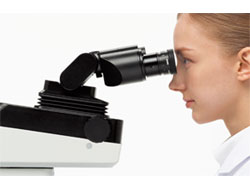 | 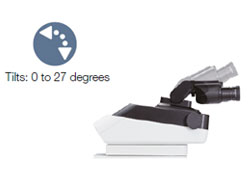 | 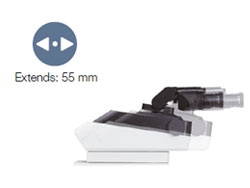 | 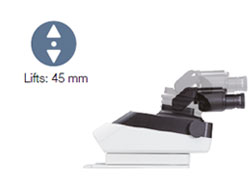 |
Figure 1: The ergonomic headpiece of the BX46 can move forwards, upwards and change inclination.
Get Comfortable in Your Routine
Olympus has developed a range of clinical microscopes that address the challenges of routine microscopy. By careful analysis of the repeated steps of routine microscopy, microscope frames were designed with optimised placement of controls and additional adjustment possibilities. The final result greatly improves the users’ comfort and productivity while minimising the risk of errors. Particularly notable is the BX46 clinical microscope, which features a unique ergonomic ‘head’ that has the flexibility to move forward, upward, and change inclination to meet the user’s eye position (figure 1).
The BX46 also has a fixed-height stage and low-positioned controls to make it easier to change specimen quickly and reduce stress on the forearms during operation (figure 2). These features specifically address the challenges of routine microscopy, helping to find the optimal user setup. As James explains, “The ideal setup is that you get your back and your neck in a neutral position and let the microscope come to you – the BX46 did exactly that.”
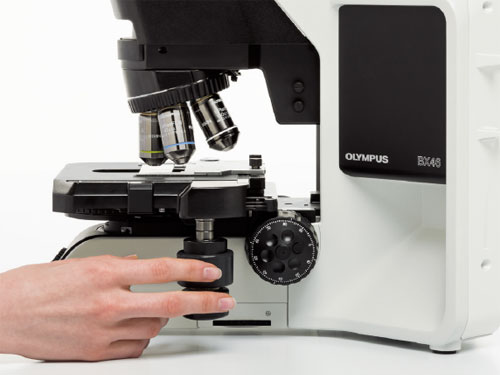
Figure 2: With the BX46’s low stage and controls the operator can rest their arms and hands
in a natural position on the desk while moving the stage and focusing the sample.
How to Set Up a Microscope Ergonomically
Once the right microscope has been selected, careful consideration is required to use the ergonomic features to their full extent. A five-point checklist can help microscopy workflows to pick up S.T.E.A.M. (Seat, Table, Eyepieces, Arms, Movement) by enabling the most comfortable posture.
Seat
You have to start from the bottom up. Start with the seat to make sure you get the right position. Make sure the bottom is at the back of the seat and that the lumbar spine is supported. Once the lumbar spine is supported, this brings a good posture to the rest of the back, which includes the neck.
Table
The next important point to consider is the position of the microscope on the table. The microscope should be brought as close to the edge of the desk as possible to prevent you from having to move forward to see through the eyepieces.
Eyepieces
When using an ergonomic microscope with a flexible head, further adjustments can be made to customise the position of the eyepieces. For example, the eyepieces can be brought closer to the operator or rotated in order to get a more horizontal viewing angle.
Arms
Without the right ergonomic setup there is often some degree of tension in the arms. Tension can be reduced by having focus controls placed in a position within reach of relaxed arms.
Movement
A final consideration for microscope setup is your ability to move once a position starts to become uncomfortable. It’s very nice to be able to make some slight movements – even if you’re in the most ergonomic position. Humans don’t like to be in the same position all day, having some variation will result in less fatigue.
|
Physiotherapist |
Case Study: Delaram Kermani, Consultant Cellular Pathologist
| The importance of a good working posture and the right microscope setup can be illustrated by the case of Delaram Kermani, consultant cellular pathologist at North Middlesex University Hospital, London, UK. Cellular pathology is an area that relies heavily on microscopy and therefore it forms an important part of the daily routine. “My role involves using a microscope four to six hours, sometimes even eight hours a day,” Delaram explains. “The job is very dependent on microscopy.” As a result of her microscopy work, Delaram started experiencing pain. “When I got the consultant post, they bought me a new microscope. The one I was using before had an ergonomic head, but the one we bought recently didn’t. First, I experienced some pain in my neck, so I started to use a book under the microscope to bring it a bit higher; then the neck pain was gone, but I started to have back pain. |
Figure 3: Olympus’ fully ergonomic BX46 upright microscope features a headpiece with three-dimensional adjustment capabilities. | The pain that Delaram experienced as a result of her routine microscopy work escalated rapidly. “I was off on sick leave because of the bad back. When I came back to work I had physiotherapy , I had back classes, and I had a lot of hydrotherapy. But as soon as I came back to work I was off sick again two weeks later.” While undergoing physiotherapy, Delaram contacted Olympus with regard to ergonomic adjustments to her microscope. “One of my colleagues suggested I should use an ergonomic head – that might help. We called the Olympus representative and he lent me a spare one to try out. When I started using that the pain gradually got better. That was really helpful and I then realised: yes, I do use it, and it is preventing my pain.” Olympus’ fully ergonomic head, as seen on the BX46 upright microscope in figure 3, provides flexibility in all directions to accommodate users of different heights working in different positions. Delaram explains: “I used to have to bring the microscope very far forward, even outside the desk, in order to be very close to the eyepieces. Now with this new head you don’t need to bring the microscope forward, you bring the head forward. You can keep your neck quite straight when you’re using it and you can imagine that if you’re using a microscope five to six hours a day it can make a big difference to the position of your neck and back.” Another important ergonomic feature of the microscope is the low height of the stage and its controls. As Delaram points out: “The stage was quite high on my previous microscope, which is why I had a lot of wrist pain. I used to use a mousepad underneath my arm to bring it a bit higher. Now I can rest my wrist on my desk rather than reaching upwards.” Delaram Kermani’s case shows the effect that selection, setup and customisation can have on user comfort. Olympus’ expertise in microscopy and ergonomics can help, both in preventing and in alleviating microscopy-related injuries. Delaram adds: “Occupational health knows about more general issues, but they may not know specifically about microscopy. In my case, Olympus definitely gave the most helpful advice.” |
Summary
When it comes to ergonomics, routine microscopy has requirements that are different to those for other microscopy users. If a user spends many working hours at the microscope, bad posture can quickly lead to back, neck, or wrist pain. Furthermore, once the pain has started, recovery can be a slow process and may require radical changes to working patterns – such as not working at the microscope at all.
Based on the demand for fully ergonomic clinical microscopes Olympus has developed the highly ergonomic BX46 microscope frame. With a 3D-adjustable headpiece, low- positioned stage and controls, and ergonomic grips it meets the rigorous demands of professionals doing routine microscopy. Not only do these features enable a comfortable routine, they also lower staff absence and enable an efficient, productive workflow.
Products Related to This Application
was successfully added to your bookmarks
Maximum Compare Limit of 5 Items
Please adjust your selection to be no more than 5 items to compare at once
Not Available in Your Country
Sorry, this page is not
available in your country.
